Adrian Collins's Blog, page 94
June 8, 2023
REVIEW: Kaikeyi by Vaishnavi Patel
While retellings have been on trend for a few years now, there is still a huge focus on Greek mythology. So Vaishnavi Patel’s Kaikeyi, based on stories and characters from the Ramayana is a welcome breath of fresh air in the genre. It tells the story of the eponymous Kaikeyi, a princess and queen, known for her heinous treatment of her stepson Rama in the legends. What makes this story stand out is that it doesn’t take away from her traditional role, from the actions ascribed to her or make her out to be a good person. This version of events sets Kaikeyi up as a complex character, intelligent and ambitious, flawed but caring and trying to consider the greater good rather than personal gain.
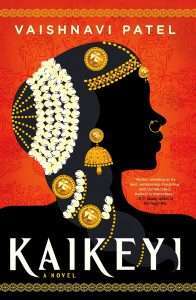 The Ramayana is one of two great Hindu epics, along with the Mahabharata. In these stories, which are thought to have been around since between the 8th and the 4th century BCE, Kaikeyi doesn’t play a very important role – she is the catalyst for the hero’s journey. In Vaishnavi Patel’s tale, she gets to tell her own story. The reader follows along as she grows from princess into a fierce woman and queen, raised on a steady diet of the gods’ (mis)adventures. Except, it turns out that they have a destiny in store for her. And so, (step)mother, warrior, diplomat, Kaikeyi has to navigate treacherous politics both human and divine.
The Ramayana is one of two great Hindu epics, along with the Mahabharata. In these stories, which are thought to have been around since between the 8th and the 4th century BCE, Kaikeyi doesn’t play a very important role – she is the catalyst for the hero’s journey. In Vaishnavi Patel’s tale, she gets to tell her own story. The reader follows along as she grows from princess into a fierce woman and queen, raised on a steady diet of the gods’ (mis)adventures. Except, it turns out that they have a destiny in store for her. And so, (step)mother, warrior, diplomat, Kaikeyi has to navigate treacherous politics both human and divine.
I loved diving into a new world of myth and legend through Kaikeyi. Usually, retellings have a sort of comfort read factor for me, where familiarity with the source material makes a first read feel like a mix between discovery and re-read, like coming home. But finding myself unmoored in a story that followed some of the conventions of the genre while missing that crucial aspect of familiarity made the reading experience really exciting. Kaikeyi still had the poetic quality of oral storytelling, of being rooted in stories that have evolved over centuries. It doesn’t quite feel like traditional secondary world fantasy. It really ignited my curiosity – and I ended my read by looking up characters and stories from the Ramayana. And that to me makes this a great book. I also found that the close first-person narration added to that feeling of oral storytelling, of immediacy, as well.
This is a slower paced story, focused on characters and politics over action. It is plenty dark though, filled with betrayals, moral cul-de-sacs and pesky fates. It is a read that pays off – and one I thoroughly enjoyed.
Read Kaikeyi by Vaishnavi PatelThe post REVIEW: Kaikeyi by Vaishnavi Patel appeared first on Grimdark Magazine.
June 7, 2023
REVIEW: The Silver Queendom by Dan Koboldt
In Old Queendom, even weary travellers avoid the Red Rooster Inn. Featuring an ale better served as a cleaning agent and terrible service, it’s small wonder this inn lacks patronage. As smoke and mirrors, this deformed inn that sits on a no name crossroad has a secret. Its crew consists of professional con artists. While the Red Rooster Inn fails to serve drinkable ale, Dan Koboldt successfully brews a timeless fantasy story of camaraderie and thievery in Silver Queendom.
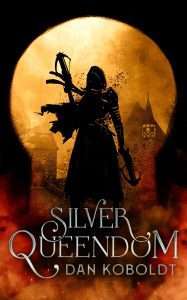 There is no shortage of schemes and mayhem in Silver Queendom. Dark times are fermenting at the Red Rooster Inn. In this part of the Old Queendom, every criminal crew pays their homage and dues to the Gray Dame. Her wrath is legendary. Her greed insatiable and seconded only by her cruelty. Due to a series of failed missions the Red Rooster has accumulated a debt to the Gray Dame. Darin, leader of the Red Rooster, knows their time is running out. The Red Rooster crew must settle their debt and soon, or die.
There is no shortage of schemes and mayhem in Silver Queendom. Dark times are fermenting at the Red Rooster Inn. In this part of the Old Queendom, every criminal crew pays their homage and dues to the Gray Dame. Her wrath is legendary. Her greed insatiable and seconded only by her cruelty. Due to a series of failed missions the Red Rooster has accumulated a debt to the Gray Dame. Darin, leader of the Red Rooster, knows their time is running out. The Red Rooster crew must settle their debt and soon, or die.
Silver Queendom is told through the perspectives of the Red Rooster’s crew. At first, Dan Koboldt introduces the reader to a familiar cast of characters. We have the leader, the seductress, the muscle, and a couple of other ragtag characters. Like their inn, the characters are more than their chosen appearance. I loved learning their back stories and troubled pasts. Each crew member is genuinely likeable. Silver Queendom holds more of a kindred spirit to Kings of the Wyld compared to The Lies of Locke Lamora.
Evil has infiltrated the governing seats in the realm. In Silver Queendom, the reader will not find sympathetic villains. We have a Queen willing to let her poor starve and oppressive lords abuse their power. I wanted more complexity with these villains, particularly with Jakub Purser. Jakub is a powerful merchant with weak hands and a tendency to beat his wife. It was all too easy to root for his downfall.
Instead, Dan Koboldt shrouds his villains in mystery. How did Jakub transform himself from a nobody to the most prosperous merchant in Caron. Who is Zora? This lady who can hand over a hundred pieces of eight in silver like it was nothing. This lady who knows too much about the Red Rooster crew.
Silver Queendom is a palate cleanser with its charming main characters and fast paced action. The comedic elements and promise of heist filled adventures are why I picked up this book. The heartfelt bond between the characters is why I finished. I hope we see more of the Red Rooster crew.
Read The Silver Queendom by Dan KoboldtThe post REVIEW: The Silver Queendom by Dan Koboldt appeared first on Grimdark Magazine.
T.R. Napper wins Aurealis Award for Best Science Fiction Novel with 36 Streets
Science fiction novelist T.R. Napper has won the Aurealis Award for Best Science Fiction Novel with his brilliant book 36 Streets, published by Titan Books. Taking home the chocolates from one of the premier speculative fiction book awards in Australia, Napper is recognised as being among the best and brightest voices in Australian science fiction.
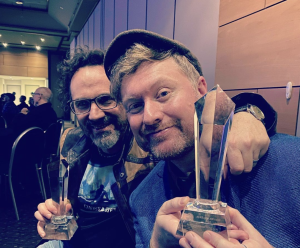
2023 Aurealis Award winners T.R. Napper (left; Best Science Fiction Novel) and Aaron Dries (right; Best Horror Novella). Photo thanks to Aaron’s Instagram account.
In 36 Streets (which I reviewed for Grimdark Magazine last year) Napper brings a Richard K. Morgan style SF noir detective story onto the streets of Vietnam. It’s an excellent, morose, beautiful in the horror of life, brutal, action packed, and gorgeous read. 36 Streets is refreshing, and brilliantly realised SF noir. And I highly, highly recommend that you pick up a copy and feed your eyes with it.
The blurb for the book reads, “Altered Carbon and The Wind-Up Girl meet Apocalypse Now in this fast-paced, intelligent, action-driven cyberpunk, probing questions of memory, identity and the power of narratives.
Lin ‘The Silent One’ Vu is a gangster in Chinese-occupied Hanoi, living in the steaming, paranoid alleyways of the 36 Streets. Born in Vietnam, raised in Australia, everywhere she is an outsider.
Through grit and courage, Lin has carved a place for herself in the Hanoi underworld under the tutelage of Bao Nguyen, who is training her to fight and survive. Because on the streets there are no second chances.
Meanwhile the people of Hanoi are succumbing to Fat Victory, an addictive immersive simulation of the US-Vietnam war. When an Englishman – one of the game’s developers – comes to Hanoi on the trail of his friend’s murderer, Lin is drawn into the grand conspiracies of the neon gods: the mega-corporations backed by powerful regimes that seek to control her city.
Lin must confront the immutable moral calculus of unjust wars. She must choose: family, country, or gang. Blood, truth, or redemption. No choice is easy on the 36 Streets.”
If you’re a cyberpunk fan and that doesn’t get your blood going, then I don’t know what bloody will. Grab yourself a copy below.
The post T.R. Napper wins Aurealis Award for Best Science Fiction Novel with 36 Streets appeared first on Grimdark Magazine.
June 6, 2023
REVIEW: Forge of the High Mage by Ian C. Esslemont
Esslemont continues his early empire Path to Ascendancy sequence impressively with the fourth instalment, Forge of the High Mage. This series is a prequel to the events of Erikson‘s Malazan Book of the Fallen and Esslemont’s own Novels of the Malazan Empire, with this entry seeing Kellanved (The Emperor), Dancer (Master Assassin), Dassem Ultor (The Sword), Tayschrenn (High Mage) and their armies advancing into Falar. Awaiting them in or approaching their destination are a powerful religious faction that worships the elder god, Mael, the tribes of the Jhek that includes soletaken wolf and bear warriors, formidable Crimson Guard mercenaries, and something mysterious and ancient that, if left unchecked, could cause devastating damage to the surrounding environment and those within the vicinity.
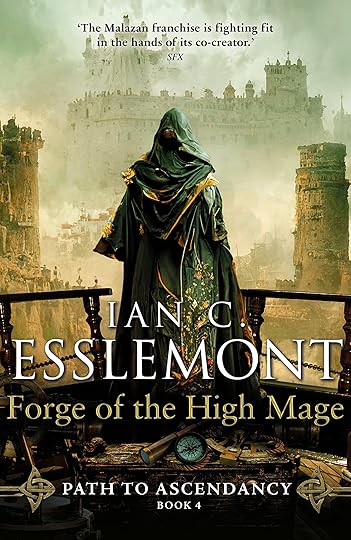 Forge of the High Mage is a book that I have been eagerly awaiting since I finished my early review copy of Kellanved’s Reach in January 2019. Fortunately, due to the fact that Esslemont’s prowess and talent as a writer is ever increasing, this novel was worth the wait. Whereas Dancer’s Lament only featured three point-of-view perspectives, Forge of the High Mage has approximately a dozen. These present a varied mix of interesting characters whose thoughts and feelings we are given witness to. The Path to Ascendancy novels are shorter, being more concise and focused, than the sweeping epics of the two main series. When reading Forge of the High Mage, like previous entries in this series, it is easier to keep track of the people, places, and the plot.
Forge of the High Mage is a book that I have been eagerly awaiting since I finished my early review copy of Kellanved’s Reach in January 2019. Fortunately, due to the fact that Esslemont’s prowess and talent as a writer is ever increasing, this novel was worth the wait. Whereas Dancer’s Lament only featured three point-of-view perspectives, Forge of the High Mage has approximately a dozen. These present a varied mix of interesting characters whose thoughts and feelings we are given witness to. The Path to Ascendancy novels are shorter, being more concise and focused, than the sweeping epics of the two main series. When reading Forge of the High Mage, like previous entries in this series, it is easier to keep track of the people, places, and the plot.
One minor criticism that I have with Forge to the High Mage, though, is that we spend less page time with the duo of Kellanved and Dancer, whose interactions are always memorable. However, by Esslemont taking them away from the absolute forefront of this narrative, he is adding to their infamy and legend, when other perspectives are deciphering the rumours or contemplating the reputation of the pair.
Readers of the two main series will be familiar with around fifty percent of the dramatis personae. Some of the finest moments of this tale occur when following a recognisable magic-wielder, the titular High Mage, Tayschrenn. The book’s title is perfect in describing his character arc: which includes his doubts and concerns, trying to understand his place within the military, his working relationship with Nightchill and Dujek Onearm, as well as his magical potential, leading to mastery. In addition to Nightchill and Dujek, other main series players that stand out include Bellurdan and Cartheron, with new members to the ensemble such as Seven Cities warrior Imanaj and faith runaway Gianna having excellent moments too.
Forge of the High Mage is a fast-paced and gripping epic fantasy read. It is loaded with set pieces, contains wonderful dialogue, witty exchanges, explosive showdowns, unlikely alliances, and features some of the finest character creations that the genre has to offer. As ever, the excellent magic system (through the use of warrens) is finely showcased here and, for the most part, I found my reading experience to be extremely rewarding; leading me to score Forge of the High Mage an 8/10 rating.
There are a couple of final points I would like to raise before finishing my review:
As mentioned, Forge of the High Mage frequently features showdowns, sometimes between some of the most powerful beings in the Malazan Universe. One such occasion, unfortunately, left me feeling frustrated as it was a blink-and-you-will-miss-it, over-in-a-page encounter. I understand that this segment was at a heightened stage in the book with regards to pacing, yet, even so, I think the breakneck speed wasted the potential of what should have been a legendary confrontation. This led me to reflect, are these set pieces truly engrossing me as much as they could as I know which characters survive (having read eighteen Malazan books so far) and have already concluded who I should be rooting for prior to these exchanges? This must be an interesting consideration for an author when creating drama for particular scenes in prequels to a popular series.
Finally, it is worth noting that there are a couple of big-name cameos in Forge of the High Mage with characters who are not directly involved in the action taking place (yet). I found that these were handled brilliantly, with a few special easter eggs for Malazan fans who read closely. These special appearances seemed more organic and purposeful than those in The God is Not Willing.
I received a finished copy of Forge of the High Mage in exchange for an honest review. Thank you to Ian C. Esslemont and Bantam Press.
Forge of the High Mage has AI cover art. Click here to see Grimdark Magazine’s AI policy.
Read Forge of the High Mage by Ian C. EsslemontThe post REVIEW: Forge of the High Mage by Ian C. Esslemont appeared first on Grimdark Magazine.
June 5, 2023
REVIEW: The Warden by Daniel M. Ford
Daniel M. Ford’s The Warden instills a warm atmosphere into a world full of grit, mystery, and necromancy. The novel embodies very familiar classic fantasy elements, but Ford’s unique twists turn them into something new.
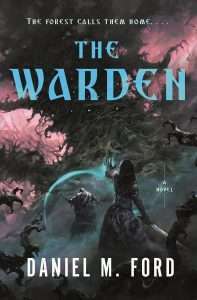 The Warden follows Aelis de Lenti, who is both the daughter of a count and a recent graduate of the Magisters’ Lyceum. Armed with her ink, pages, and no-nonsense approach, Aelis always has a plan until she’s sent to Lone Pine, about as far from a city as she can get. Aelis trades her books for tools and faces off against her goat nemesis in an attempt to build trust with the villagers. As Aelis finally achieves a cordial existence, the villagers’ behavior shifts in peculiar ways. Outside the walls of the Lyceum lies age-old secrets and the ancient magics guarding them. Aelis will have to rise to the occasion, standing between the darkness eliciting itself from Lone Pine and the people she’s sworn to protect.
The Warden follows Aelis de Lenti, who is both the daughter of a count and a recent graduate of the Magisters’ Lyceum. Armed with her ink, pages, and no-nonsense approach, Aelis always has a plan until she’s sent to Lone Pine, about as far from a city as she can get. Aelis trades her books for tools and faces off against her goat nemesis in an attempt to build trust with the villagers. As Aelis finally achieves a cordial existence, the villagers’ behavior shifts in peculiar ways. Outside the walls of the Lyceum lies age-old secrets and the ancient magics guarding them. Aelis will have to rise to the occasion, standing between the darkness eliciting itself from Lone Pine and the people she’s sworn to protect.
The Warden’s strength lies with Ford’s concepts and ideas. Between the fantastical races and magical terminology, the reader can ground themselves easily in the narrative. As the story builds, those known aspects deviate from predictable directions in interesting and surprising ways. The standout moment for me involves this merge of classic fantastical elements with a fresh modern perspective, centering on a particular tree. Ford’s choice of Aelis’ characterization also helps strengthen the reader’s attachment to the novel. Rather than an experienced warden with vast pools of knowledge and hardened combat skills, Aelis is untried and lacks any real-world applicability. Her reactions to the situations she finds herself in at Lone Pine feel natural and real, making her relatable.
Where some readers might take issue is with the pacing and the page count. Though the book is just over 300 pages, it takes some time for the story to evolve. The Warden’s cozier focus is firmly rooted in the exploration of Lone Pine through Aelis’ eyes. This narrative choice made for a slower start. Paired with the pacing, the book’s brevity might leave readers wanting more. It scratches the surface of its more intriguing elements without diving deep. Though the skeleton of the narrative is present, additional time could have been spent on the connective tissue to flesh out the story more. Granted, this is the first installment of a new series, so a more in-depth expansion might be found in the upcoming sequel, Necrobane.
While it falls on the cozier side of the fantasy genre, grimdark fans will appreciate The Warden for the grit and lore of its world-building. Aelis’ transition from academia to the outside world will also bring about a sense of nostalgia, ringing true in a heartfelt way. Her journey is one that spans many forms in terms of relatability:
“Nothing…can run forever. That is one of the first rules we learn. Nothing, whether made by the skill of a person’s hands or by the craft of their magic, can run indefinitely. Everything has only the amount of power we give it” (89).
Thank you to Tor for sending me a copy of The Warden to review.
Read The Warden by Daniel M. FordThe post REVIEW: The Warden by Daniel M. Ford appeared first on Grimdark Magazine.
June 4, 2023
REVIEW: Fractal Noise by Christopher Paolini
Fractal Noise is the second book within Christopher Paolini’s Fractalverse, serving as a prequel to 2020’s To Sleep in a Sea of Stars. You don’t need to have read the first book to understand what’s happening in Fractal Noise, as this story is much more scaled down: playing out over a number of days in a single location as opposed to the epic, sweeping scope of …Sea of Stars.
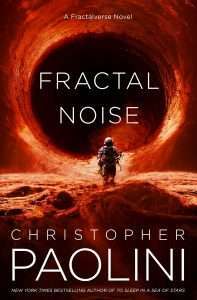 It is important to note, before I continue with the review, the controversy around Fractal Noise’s cover art. It was observed, shortly after the cover was revealed, that it contained a base image that had been AI-generated. Grimdark Magazine does not condone the use of AI technologies and you can read our full statement on that here: https://www.grimdarkmagazine.com/grimdark-magazines-statement-on-ai-technologies This review focusses on the contents of the book and its story.
It is important to note, before I continue with the review, the controversy around Fractal Noise’s cover art. It was observed, shortly after the cover was revealed, that it contained a base image that had been AI-generated. Grimdark Magazine does not condone the use of AI technologies and you can read our full statement on that here: https://www.grimdarkmagazine.com/grimdark-magazines-statement-on-ai-technologies This review focusses on the contents of the book and its story.
If you have read …Sea of Stars, you may recall mention of the ‘Anomaly’ and it is the discovery of this that is the focus of Fractal Noise. The crew of the Adamura, on a survey mission, discovers a 50km wide hole, perfectly circular, on the surface of uninhabited planet Talos VII. The hole continues down into the planet so far they cannot get readings on its true depth. Is this evidence of sentient life in the universe, besides humans? As they examine the hole from orbit they realise it is broadcasting a mathematical pattern out into space, it is producing Fractal Noise.
Some crew volunteer to land on Talos VII and make the trip across the surface to the hole to try and investigate it’s purpose. The book is primarily the story of this journey. We have one POV, that of Alex Crichton (no relation to John or Michael), a man deep in the throes of grief. The love of his life, Layla, died not long before he ran away to join the Adamura. Alex is not in the best of mental states, to say the least. He takes it upon himself to travel to the hole in honour of his lost wife, much as he would otherwise prefer not to.
Four crew set out on the surface to walk nearly 100km to the Anomaly, including Crichton, as the noise emitted from the hole prevents landing any closer. Harsh winds batter the surface of the planet and the away team have to struggle against it as they advance. Tragedy begins to affect the crew as one member of the team suffers a catastrophic leg break. Tensions flare between the God-fearing team leader and the nihilistic hedonist geologist as both try to win over the hearts and minds of their fellow crew.
Crichton, meanwhile, spends his time zoning out and reliving memories of Layla. Unaware of the severity and extent of the mounting pressure around him, it comes as some surprise to him when order breaks down completely. Lost in his own grief, Alex convinces himself that if the expedition ends, so too will he. Forcing himself to continue, he eventually reaches the Anomaly and finds a reason to continue living.
Fractal Noise is more character study than epic Sci-fi in nature; it is instead a musing on grief and purpose. The debates between the religious and secular characters, Alex’s internal conflicts on his role in his wife’s death, the unknown purpose of the Anomaly or who created it, all come together to form a more philosophical work then we saw in …Sea of Stars.
The execution of Fractal Noise’s delve into the human psyche is, at times, a little clumsy. The faithful and faithless duo of characters are positioned at total extremes to one another with no flexibility – making it rather obvious that they’re only there to make a point. Crichton’s situation is awfully similar to Kyra’s from …Sea of Stars; they both experience grief in the violent loss of a partner, they’re both investigating alien artefacts through a xenoarchaeological lens while on ‘routine surveying missions’, they both end up alone and separated from their crew, and it ended up feeling a touch lazy having these very direct links between the two characters drawn out for us.
On the theme of clumsiness, there are times when the language used felt a little overdone. If you feel the need to use uncommon vocabulary, it is best to do so sparingly. The word ‘inexorable’ appeared three times in under 250 pages, which was glaringly obvious to me and made it feel out of place each time.
Overall, Fractal Noise does deliver a competent exploration of grief and the human search for purpose but that wasn’t what I was expecting when I started reading. It is a very different book to …Sea of Stars and I had envisaged more of the hard sci-fi I enjoyed from that. Fractal Noise feels a bit confused because of this; the story could easily have been played out in a modern-day, realistic setting to the extent that the sci-fi elements are largely superfluous. While it will take you through a harrowing tale of loss, it is occasionally let down by clumsy language and world-building. It seems to add little to the Fractalverse lore at large but remains an interesting enough encounter.
3/5
Read Fractal Noise by Christopher PaoliniThe post REVIEW: Fractal Noise by Christopher Paolini appeared first on Grimdark Magazine.
June 3, 2023
REVIEW: Medusa’s Sisters by Lauren J.A. Bear
Medusa is more immortalized than many of the women of Greek myths. She’s a cultural phenomenon depicted in poetry, art, and famously featured in one of the most significant moments in film animation history. Most often she’s familiar as a traumatic story of rape made monstrous by society. It’s a horror story that still survives in modern-day courts. The biting snakes on her head never quite manage to erase her humanity–for the deeper truths go skin deep for an audience that asks people to be vulnerable. In Lauren J. A. Bear’s mythological and monstrous Medusa’s Sisters, this legendary woman and her tragedy unfold through the perspective of her immortal sisters.
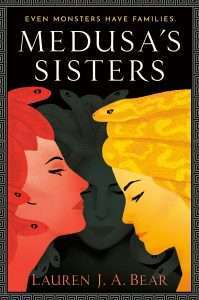 Medusa’s Sisters starts with Stheno, Medusa’s eldest sister, as she introduces a tale about monstrous women, family, and the creation of the world. Envision god-touched mothers, the origins of the gorgons, and the golden age of the Titan gods. Those little details left and abandoned as juicy footnotes are deep dives in Medusa’s Sisters. Echidna, the mother of monsters like Hydra, Cerberus, and the Sphinx. Typhon, her tender husband, slithers on viper tails and has eyes of fire. Their family can easily be heartfelt and ruthless the next. It isn’t until the age of the Olympians that their story really hits off.
Medusa’s Sisters starts with Stheno, Medusa’s eldest sister, as she introduces a tale about monstrous women, family, and the creation of the world. Envision god-touched mothers, the origins of the gorgons, and the golden age of the Titan gods. Those little details left and abandoned as juicy footnotes are deep dives in Medusa’s Sisters. Echidna, the mother of monsters like Hydra, Cerberus, and the Sphinx. Typhon, her tender husband, slithers on viper tails and has eyes of fire. Their family can easily be heartfelt and ruthless the next. It isn’t until the age of the Olympians that their story really hits off.
Stheno is the more reserved sister. Euryale, the middle sister, looks at the Olympians akin to modern-day gossip about celebrity icons. Medusa, the youngest, endeavors to be like the humans. The gods around them form relationships with the sisters, whom all want fresh experiences–to find their place in the world together. Poseidon, Lord of the Sea, becomes an object of desire and a target for Euryale’s ambitious aspirations to be as revered as the Olympians. Capturing the eye of a god is tricky, and Euryale is determined to seek out those more experienced in love than her.
From city to city, the sisters learn the sensitivity of humans–and how easily a god’s seduction can turn volatile. The women are really the focus of Medusa’s Sisters, and they are not pinned down by society’s standards. Princesses they meet on the way, such as Semele, have no worries about likeability. Her arrogance and loud, drunk-filled nights are refreshing for refusing to be weighed down by complex men and dull but perfect women. Similarly, the sisters also seek out what they want in life. Sexual curiosities are not just for the mortals here. Examinations of the self, the body, and identity become a major theme as the sisters navigate a world dangerous for monstrous women. It’s their risk to do normal things any human would have the right to do that seems most relatable by modern-day events, such as society pointing fingers at the sexual assault victim. Medusa’s Sisters is not meant for the reader who wants a friend in the characters, as it’s about those who have lived with mythologically epic wrongs done to them.
In Medusa’s Sisters, the trauma survivors go through is depicted with intentional detail. It’s horribly uncomfortable, as much of the novel is meant to be about the stories of survivors. Much of the novel features risky choices, but not all of them follow through. Bear is good at showing the story, but there are some obvious mismanaged parts. Multiple scenes with dialogue guilt a survivor into carrying a baby to term because, as explained, the baby is innocent of its conception. This is a decision in the story that I had difficulty wrapping my head around, as it’s said by someone normally empathetic and sensitive. It is not the dialogue itself that is the issue, but how this anti-abortion rhetoric is performed based on characterization already laid out. Something being said isn’t explicitly wrong, as it’s entirely up to who is saying it and what is shown throughout the entire novel. It’s an out-of-character choice that puzzled me. To carry a child by sexual assault is a difficult one forced upon many real people who already have a lifetime worth of trauma ahead of them. It felt oddly out of place.
Medusa’s Sisters takes after the feminist mythology retellings, yelling that memory is shaped by who tells it. Ancient, deep, and boiling with divine prose. With complex and utterly fascinating characters, it is disappointing that Medusa’s Sisters left me sour toward the end.
Read Medusa’s Sisters by J.A. BearThe post REVIEW: Medusa’s Sisters by Lauren J.A. Bear appeared first on Grimdark Magazine.
REVIEW: Medusa’s Sisters by J.A. Bear
Medusa is more immortalized than many of the women of Greek myths. She’s a cultural phenomenon depicted in poetry, art, and famously featured in one of the most significant moments in film animation history. Most often she’s familiar as a traumatic story of rape made monstrous by society. It’s a horror story that still survives in modern-day courts. The biting snakes on her head never quite manage to erase her humanity–for the deeper truths go skin deep for an audience that asks people to be vulnerable. In Lauren J. A. Bear’s mythological and monstrous Medusa’s Sisters, this legendary woman and her tragedy unfold through the perspective of her immortal sisters.
 Medusa’s Sisters starts with Stheno, Medusa’s eldest sister, as she introduces a tale about monstrous women, family, and the creation of the world. Envision god-touched mothers, the origins of the gorgons, and the golden age of the Titan gods. Those little details left and abandoned as juicy footnotes are deep dives in Medusa’s Sisters. Echidna, the mother of monsters like Hydra, Cerberus, and the Sphinx. Typhon, her tender husband, slithers on viper tails and has eyes of fire. Their family can easily be heartfelt and ruthless the next. It isn’t until the age of the Olympians that their story really hits off.
Medusa’s Sisters starts with Stheno, Medusa’s eldest sister, as she introduces a tale about monstrous women, family, and the creation of the world. Envision god-touched mothers, the origins of the gorgons, and the golden age of the Titan gods. Those little details left and abandoned as juicy footnotes are deep dives in Medusa’s Sisters. Echidna, the mother of monsters like Hydra, Cerberus, and the Sphinx. Typhon, her tender husband, slithers on viper tails and has eyes of fire. Their family can easily be heartfelt and ruthless the next. It isn’t until the age of the Olympians that their story really hits off.
Stheno is the more reserved sister. Euryale, the middle sister, looks at the Olympians akin to modern-day gossip about celebrity icons. Medusa, the youngest, endeavors to be like the humans. The gods around them form relationships with the sisters, whom all want fresh experiences–to find their place in the world together. Poseidon, Lord of the Sea, becomes an object of desire and a target for Euryale’s ambitious aspirations to be as revered as the Olympians. Capturing the eye of a god is tricky, and Euryale is determined to seek out those more experienced in love than her.
From city to city, the sisters learn the sensitivity of humans–and how easily a god’s seduction can turn volatile. The women are really the focus of Medusa’s Sisters, and they are not pinned down by society’s standards. Princesses they meet on the way, such as Semele, have no worries about likeability. Her arrogance and loud, drunk-filled nights are refreshing for refusing to be weighed down by complex men and dull but perfect women. Similarly, the sisters also seek out what they want in life. Sexual curiosities are not just for the mortals here. Examinations of the self, the body, and identity become a major theme as the sisters navigate a world dangerous for monstrous women. It’s their risk to do normal things any human would have the right to do that seems most relatable by modern-day events, such as society pointing fingers at the sexual assault victim. Medusa’s Sisters is not meant for the reader who wants a friend in the characters, as it’s about those who have lived with mythologically epic wrongs done to them.
In Medusa’s Sisters, the trauma survivors go through is depicted with intentional detail. It’s horribly uncomfortable, as much of the novel is meant to be about the stories of survivors. Much of the novel features risky choices, but not all of them follow through. Bear is good at showing the story, but there are some obvious mismanaged parts. Multiple scenes with dialogue guilt a survivor into carrying a baby to term because, as explained, the baby is innocent of its conception. This is a decision in the story that I had difficulty wrapping my head around, as it’s said by someone normally empathetic and sensitive. It is not the dialogue itself that is the issue, but how this anti-abortion rhetoric is performed based on characterization already laid out. Something being said isn’t explicitly wrong, as it’s entirely up to who is saying it and what is shown throughout the entire novel. It’s an out-of-character choice that puzzled me. To carry a child by sexual assault is a difficult one forced upon many real people who already have a lifetime worth of trauma ahead of them. It felt oddly out of place.
Medusa’s Sisters takes after the feminist mythology retellings, yelling that memory is shaped by who tells it. Ancient, deep, and boiling with divine prose. With complex and utterly fascinating characters, it is disappointing that Medusa’s Sisters left me sour toward the end.
Read Medusa’s Sisters by J.A. BearThe post REVIEW: Medusa’s Sisters by J.A. Bear appeared first on Grimdark Magazine.
June 2, 2023
REVIEW: Nothing but the Rain by Naomi Salman
Rain washes away memories in Naomi Salman’s apocalyptic debut novella, Nothing but the Rain. The novella is set in the stormy town of Aloisville, an isolated village with fewer than two hundred inhabitants whose memories are rinsed away with every raindrop.
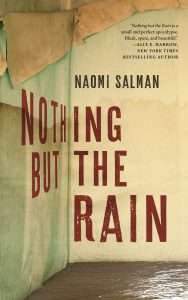 The story is told as a series of journal entries by sixty-three-year-old Laverne, a retired doctor who keeps a diary as a “backup brain.” Suspecting chemical contamination of the water, Laverne conducts experiments in puddles and her bathtub to test the effects on her own memory.
The story is told as a series of journal entries by sixty-three-year-old Laverne, a retired doctor who keeps a diary as a “backup brain.” Suspecting chemical contamination of the water, Laverne conducts experiments in puddles and her bathtub to test the effects on her own memory.
Aloisville is also under a suspicious military quarantine. It is unclear whether the quarantine is meant for the safety of the Aloisville residents or to prevent them from spreading news of their dire situation.
Laverne experiences few human interactions in Nothing but the Rain and struggles to remember people’s names. Her main interactions are with a distrusting neighbor, Katie, and her young daughter, Zoe.
Although written as a dystopian sci-fi story about environmental disaster, Nothing but the Rain also serves as an allegory for the onset of dementia:
“Sometimes I wish I could forget what’s been happening. Then I remember that’s what I’m most afraid of.”
Naomi Salman expertly probes the link between memory and sanity. Laverne is afraid of forgetting, and the loss of memory makes her paranoid. Yet the suppression of memory can also act as a coping mechanism for those who have undergone trauma.
Nothing but the Rain further examines the lengths to which people will go to exploit memory loss in others. In this way, Nothing but the Rain explores a spectrum of gray morality that mirrors the perpetually gray, rainy days of Aloisville.
Naomi Salman’s writing is spare and haunting. Nothing but the Rain makes expert use of unreliable narration to keep the reader guessing and to bring an unexpectedly satisfying conclusion to the story.
The worldbuilding in Nothing but the Rain is slight but captivating. Naomi Salman employs the minimal level of worldbuilding necessary to tell her story, which works quite effectively for this short novella. Still, the end of the novella came too soon for my taste, leaving me thirsty for more time in this world. Additional material would deepen the themes already presented in this excellent novella and create an even more immersive experience.
Naomi Salman’s debut novella is delicate yet disturbing. Memories may fade, but Nothing but the Rain will linger with me for a long time.
4/5
Read Nothing but the Rain by Naomi SalmanThe post REVIEW: Nothing but the Rain by Naomi Salman appeared first on Grimdark Magazine.
June 1, 2023
Review: A Sleight of Shadows by Kat Howard
A Sleight of Shadows by Kat Howard, part of The Unseen World series perfectly expresses a dark and complicated story interlaced with an exciting magic system. If anything we have learned from the slightly twee world of Harry Potter is that there is a yearning and readership for the darker types of magic for adult readers. Especially ones where there are huge prices to pay for the use of magic, because nothing good can come free.
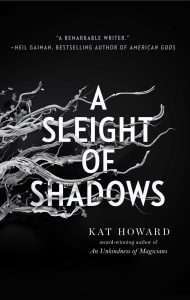 Much like the series’ first novel, An Unkindness of Magicians, A Sleight of Shadows stars a cast of characters and viewpoints. However most of our story is expressed by our protagonist Sydney, and the newcomer to magic Mia. In nature, ravens flock together in something called “unkindness.” And while the symbolism of ravens is not overt, calling a group of magicians an unkindness resonates and perfectly encapsulates Kat Howard’s dark world. Sydney battled and fought hard in book one and made tremendous sacrifices destroying an integral part of herself to bring down The House of Shadows. Now as things escalate again and her choices of how to deal with the new power dynamic change, Sydney has to adapt or be destroyed.
Much like the series’ first novel, An Unkindness of Magicians, A Sleight of Shadows stars a cast of characters and viewpoints. However most of our story is expressed by our protagonist Sydney, and the newcomer to magic Mia. In nature, ravens flock together in something called “unkindness.” And while the symbolism of ravens is not overt, calling a group of magicians an unkindness resonates and perfectly encapsulates Kat Howard’s dark world. Sydney battled and fought hard in book one and made tremendous sacrifices destroying an integral part of herself to bring down The House of Shadows. Now as things escalate again and her choices of how to deal with the new power dynamic change, Sydney has to adapt or be destroyed.
But what I missed wholeheartedly in A Sleight of Shadows was a connection to the characters; I wanted to care desperately about the trials and tribulations they faced. What Sydney, Mia, and company are confronting is no small thing, so where was the emotion, the rage? In the first book, Kat Howard wrote words that practically dripped venom in An Unkindness of Magicians. The characters of A Sleight of Shadows had much less emotional depth and they felt oddly similar to each other, aside from heartbreaking scenes at the story’s end.
Mechanically, the story is well-written. The action scenes are well done, as is in any of Howard’s novels. The overall ambiance is there as well. When I think of Howard’s books, all of her books remind me of a beautiful garden full of roses that want to prick you until you have had blood running down your arms. Beautiful and cruel. And this certainly achieved that feeling. That I loved, and this aura her books have will always have me clamoring for more of her work.
Also, I got quite a kick out of the new characters, kids really. Everyone needs to start somewhere, and the excitement mixed with naivete was endearing. If allowed to do some magic, I would be excited beyond belief.
However again, the je ne se quois prevalent in the first book is missing here. Yes, all the pieces are present. We have a great cast of characters. We have necessary complications, such as a new crop of magicians to add new life and new perspectives. We have excellent pacing, as we did in the first novel. We have a very similar story to the first novel.
But ground altogether, the story still feels flat.
As a reader, if there were another 100 pages of story, characters, and plot, I would undoubtedly be much more enthralled. But as it stands, it did not entirely excite me as much as I wish it had. However, the book has many good things. Much like any of Kat Howard’s novels, I suggest giving it a chance as your mileage may vary.
3.5/5
Read A Slight Of Shadows by Kat HowardThe post Review: A Sleight of Shadows by Kat Howard appeared first on Grimdark Magazine.



